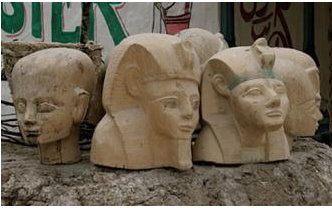 The good people of St Louis have in their city a museum which has a mummy mask from a Ramesside burial at Sakkara, excavated in 1952. The Museum trustees insist the object came onto the market soon after excavation by entirely legitimate means. The Egyptian authorities however say this is not true and allege it came onto the market after a theft from a museum storeroom in the 1980s. So are the citizens of St Louis harbouring a stolen artwork?
The good people of St Louis have in their city a museum which has a mummy mask from a Ramesside burial at Sakkara, excavated in 1952. The Museum trustees insist the object came onto the market soon after excavation by entirely legitimate means. The Egyptian authorities however say this is not true and allege it came onto the market after a theft from a museum storeroom in the 1980s. So are the citizens of St Louis harbouring a stolen artwork?There is a question that St Louis Art Museum has not yet answered, and I would like the people of St Louis to ask the Museum's trustees for an answer.At some stage in its collecting history the object has been tampered with and this has led to the concealment of a vital piece of information about its origins and associations.
Indeed it is not. The inscription could be transcribed into something that looked like this:When the mask was originally found, there was a hieratic inscription in black ink near the thumb on the left hand reading from right to left "Neferu". ie. The name of the owner. This is visible in old pictures of the mask but was apparently rubbed off when the object was sold onto the antiquities market. It is not visible in modern pictures (from K. M. Johnston's wiki page on the Ka Nefer Nefer burial).
 It reads "The Osiris, Neferu".
It reads "The Osiris, Neferu".The erasure of this inscription raises an important question, when and by whom was this done and why?
Let us note that the assurance by the dealer who sold it to SLAM that the object was licitly obtained relies on a chain of ownership, each owner being assured that the object was legitimately on the market and passing that assurance on to the next owner.
Secondly most collectors would value an object with an inscription linking it to a particular person (and in this case, since it is published, a particular findspot) over an anonymous, generic, object. Quite apart from any ethical issues, removing the inscription reduces the value of the mask as a collectable, removes a part of the "story" it can tell.
These are two good reasons why a collector who believed the object was legitimately obtained would not remove the inscription naming the person it represents.
There is however a very good reason for removing the inscription. If the object was stolen and somebody was intending to sell it, it would have been rather awkward if the potential buyer did a search for the name in a resource like Porter-Moss and found the Goneim Sakkara "Neferu" mask in the literature and started asking questions. Removing the name makes it more difficult for the average buyer to make the connection (SLAM obviously did not). It reduces the risk that the object will be immediately identified as of illicit origins.
Removing the name makes sense ONLY if the person selling this object knows it has been illicitly-obtained.
So now we have a plausible reason "why", we may ask when and by whom was this done?
- By the dealer in an unnamed Brussels gallery where, according to the Phoenix-SLAM version of the collecting history, it was seen by a Swiss man (Charly Mathez) in the 1950s?Let the Trustees of St Louis Art Museum answer the question, how would the fact that any of these people would have altered the object in this manner square with their story that the object was checked out by SLAM staff and they found no evidence that the object was not of licit provenance? Is not the erasure of this inscription evidence in itself that somewhere along the line one of the sellers was trying to hide something? Doing proper due diligence before purchase surely would entail finding out what that was, and if that was impossible, walking away from the deal. What is the preferred explanation of the Trustees of St Louis Art Museum for the removal of the inscription, and will we or the people of St Louis ever hear it? Maybe somebody there can ask them outright.
- In the collection of one "Kaloterna" (Kaliterna?) family, according to the Phoenix-SLAM version of the collecting history, until the early 1960s.
- In the early 1960s, according to the Phoenix-SLAM version of the collecting history, when it was bought by a Swiss collector named "Zuzi Jelinek"?
- Four decades later, when it came into the possession of the dealers Phoenix Ancient Art in 1997?
- When the St Louis Art Museum bought it in 1998?

 What do crustaceans live on?
What do crustaceans live on?








 How the visualisation was made
How the visualisation was made














